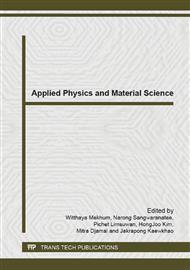[1]
X. Fang, T. Zhai, U. K. Gautam, L. Li, L. Wu, Y. Bando, D. Golberg, ZnS nanostructures: From synthesis to applications, Prog. Mater. Sci. 56 (2011) 175-287.
DOI: 10.1016/j.pmatsci.2010.10.001
Google Scholar
[2]
S. Wang, D. Yu, G. Wu, J. Guo, C. Lei, A new fluorescent film sensor for Pb(II) ions developed by simulating bio-mineralization process synthesizing of ZnS/CS nanocomposite, Mater. Sci. Eng. B. 176 (2011) 873-877.
DOI: 10.1016/j.mseb.2011.05.002
Google Scholar
[3]
Z.H. Chen, H. Tang, X. Fan, J.S. Jie, C.S. Lee, S.T. Lee, Epitaxial ZnS/Si core–shell nanowires and single-crystal silicon tube field-effect transistors, J. Cryst. Growth. 310 (2008) 165-170.
DOI: 10.1016/j.jcrysgro.2007.09.047
Google Scholar
[4]
D. A. Reddy, G. Murali, N. M. Rao, R.P. Vijayalakshmi, B.K. Reddy, Synthesis and Optical Properties of Annealed Cr Doped ZnS Nanoparticles, Adv. Mat. Res. 678 (2013) 163-167.
DOI: 10.4028/www.scientific.net/amr.678.163
Google Scholar
[5]
Q. F. Han, G. Z. Diao, X. H. Liu, X. Wang, The Preparation and Photocatalytic Activity of Ni-Doped ZnS Nanoparticles, Adv. Mat. Res. 148 – 149 (2010) 845-848.
DOI: 10.4028/www.scientific.net/amr.148-149.845
Google Scholar
[6]
Z. Y. Zhong, E. S. Cho, S. J. Kwon, Characterization of the ZnS thin film buffer layer for Cu(In, Ga)Se2 solar cells deposited by chemical bath deposition process with different solution concentrations, Mater. Chem. Phys. 135 (2012) 287-292.
DOI: 10.1016/j.matchemphys.2012.03.090
Google Scholar
[7]
Z. Cao, L. Sun, X. Cao, Y. He, Preparation and Characterization of Helical Structure ZnS by Solvothermal Method, Adv. Mat. Res. 233 - 235 (2011) 1954-(1957).
Google Scholar
[8]
X. Yan, E. Michael, S. Komarneni, J. R. Brownson, Z. -F. Yan, Microwave- and conventional-hydrothermal synthesis of CuS, SnS and ZnS: Optical properties, Ceram. Int. 39 (2013) 4757-4763.
DOI: 10.1016/j.ceramint.2012.11.062
Google Scholar
[9]
M. Salavati-Niasari, F. Davar, M. Mazaheri, Synthesis and characterization of ZnS nanoclusters via hydrothermal processing from [bis(salicylidene)zinc(II)], J. Alloy. Compd. 470 (2009) 502-506.
DOI: 10.1016/j.jallcom.2008.03.048
Google Scholar
[11]
P.K. Ghosh, U.N. Maiti, S. Jana, K.K. Chattopadhyay, Field emission from ZnS nanorods synthesized by radio frequency magnetron sputtering technique, Appl. Surf. Sci. 253 (2006) 1544-1550.
DOI: 10.1016/j.apsusc.2006.02.037
Google Scholar
[12]
W. Chen, X. Xu, P. Dai, Y. Chen and Z. Jiang, Properties of ZnS Thin Films Prepared by CBD under Different Concentration of Complexing Agent, Adv. Mat. Res. 472 - 475 (2012) 1572-1576.
DOI: 10.4028/www.scientific.net/amr.472-475.1572
Google Scholar
[13]
S.Y. Lee, Y.H. Shin, Y. Kim, S. Kim, S. Ju, Thermal quenching behavior of emission bands in Eu-doped ZnS nanowires, J. Lumin. 131 (2011) 1336-1339.
DOI: 10.1016/j.jlumin.2011.03.026
Google Scholar
[14]
Y. -y. SHE, J. YANG, K. -q. QIU, Synthesis of ZnS nanoparticles by solid-liquid chemical reaction with ZnO and Na2S under ultrasonic, T. Nonferr. Metal. Soc. 20 (2010) s211-s215.
DOI: 10.1016/s1003-6326(10)60041-6
Google Scholar
[15]
H. Z. Zeng, K. Q. Qiu, Y. Y. Du, W. Z. Li, A new way to synthesize ZnS nanoparticles, Chinese. Chem. Lett. 18 (2007) 483-486.
DOI: 10.1016/j.cclet.2007.02.002
Google Scholar
[16]
J. Duan, X. Huang, H. Wang, Q. Zhong, F. Sun, X. He, Synthesis of porous ZnO micro-flakes via an integrated autoclave and pyrolysis process, Mater. Chem. Phys. 106 (2007) 181-186.
DOI: 10.1016/j.matchemphys.2007.05.034
Google Scholar
[17]
L. Wu, Y. Wu, Y. Lu, Self-assembly of small ZnO nanoparticles toward flake-like single crystals, Mater. Res. Bull. 41 (2006) 128–133.
DOI: 10.1016/j.materresbull.2005.07.031
Google Scholar


